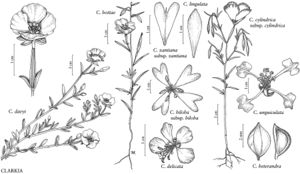Clarkia unguiculata
Edwards’s Bot. Reg. 23: sub plate 1981. 1837.
Stems erect, 30–100 cm, glabrous, glaucous. Leaves: petiole 0–10 mm; blade lanceolate to elliptic or ovate, 1–6 cm. Inflorescences open racemes, sometimes branched, axis erect; buds pendent. Flowers: floral-tube 2–5 mm; sepals reflexed together to 1 side, green to dark red, sparsely to densely puberulent abaxially, with longer, straight, spreading hairs to 3 mm; corolla rotate, petals lavender-pink to salmon or dark reddish purple, triangular or diamond-shaped to suborbiculate, 10–25 mm, claw slender, equal to or longer than blade, entire, rarely somewhat expanded at base; stamens 8, unequal, outer anthers red, inner smaller, paler; ovary with hairs as on sepals; stigma exserted beyond anthers. Capsules 15–30 mm. Seeds brown, 1–1.5 mm, tuberculate, crest inconspicuous. 2n = 18.
Phenology: Flowering Apr–Sep.
Habitat: Woodlands.
Elevation: 0–1500 m.
Discussion
Clarkia unguiculata is a widely distributed species in California, and occurs throughout much of the southern two-thirds of the state in appropriate woodland habitats.
Clarkia unguiculata is ancestral to C. exilis, C. springvillensis, and C. tembloriensis. It is one of the parents of the tetraploid species C. delicata and may have been involved in the origin of C. heterandra.
Selected References
None.
